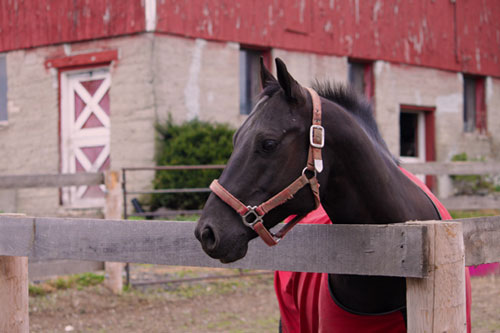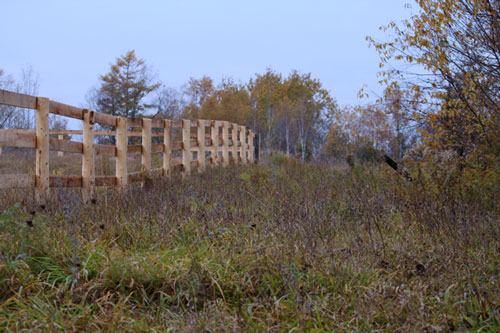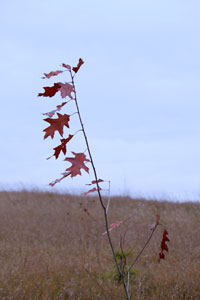ARCHIVE EQUINE NEWS STORIES
| Current news is available at TheHorsePortal.ca, Equine Guelph's online learning platform for practical, quick learning. Given the vast amount of information on horse health and welfare, Equine Guelph has archived its past news articles from 2002-2020. They are listed below, along with a search function available to find specific healthcare topics. | |
New horse facility owners harness the power of partnershipsAugust 2010
By Mark Eastman, Credit Valley Conservation
When Doug and Debbie Hart purchased their farm and horse facility in Caledon this past spring, it was a long-held dream come true. “After growing up in a city subdivision and eventually moving to Caledon, we knew we loved the area,” said Doug. “We decided to look north, and by coincidence ended up buying the farm that our daughter used to ride at 15 years earlier.”

The Harts’ Trailwood Farms offers boarding, training, trail riding and lessons for kids and adults. Trailwood features more than 55 acres of rolling hills, pasture, paddock, streams and wetlands, situated in the Credit River Watershed on the Oak Ridges Moraine.
As new farmers, the Harts take their responsibility as stewards of the land very seriously. They have found a great deal of help along the way, including programs that provide expertise, assistance and funding for environmental improvements.
Doug Hart has even gone back to school, completing the Canada-Ontario Environmental Farm Plan Workshop hosted by the Ontario Soil and Crop Improvement Association. At the workshop, Doug completed an environmental assessment of his property and pinpointed those areas that require environmental improvements. “It was a real education on the whole environmental issue,” said Doug. “I’d recommend it to anybody who is farming.”
The Harts’ property is a varied landscape, and while some of it is not suitable for pasture land, these areas have provided the focus for the couple’s first environmental improvement efforts. Starting with an area of sloping and wet low land, the Harts worked with Credit Valley Conservation (CVC) to implement a planting project. They selected a diverse mix of native trees and shrubs such as tamarack, maple and dogwood. The plantings will help reduce erosion by stabilizing soils on the steep hill, and will provide a habitat for wildlife. Cost-share funding for the planting project was provided by Peel Region’s tree planting subsidy and the Oak Ridges Moraine Foundation’s “Caring for the Moraine” Project.
One of the key features of the Harts’ farm from an environmental perspective is a stream that passes through a number of provincially significant wetlands before feeding into the Credit River. To help protect this important stream from the negative impacts of nutrients in pasture runoff, the Harts have increased the distance between their pastures and wetlands by installing new fences. The cost of the fencing project was subsidized by the Peel Rural Water Quality Program.

Excessive nutrient rich runoff is damaging to wetlands and streams, promoting algae growth, reducing oxygen levels in the water, and compromising the health of aquatic life in the river and downstream to Lake Ontario. This spring the Harts plan to have CVC reforest the buffer area between the new fencing and the wetland. The expanded buffer will provide enhanced wildlife habitat and reduce the amount of surface runoff entering the wetland during heavy rainstorms.
As they make improvements to their land in the coming years, the Harts will be able to seek the support of a number of environmental partners and programs including the Ontario Soil and Crop Improvement Association, and the Peel Rural Water Quality Program, funded by the Region of Peel and administered cooperatively by CVC and Toronto and Region Conservation Authority.
“Support for farm improvement initiatives comes from the federal, provincial and local levels, as well as various not-for-profit groups. It speaks to just how important these projects are,” said Mike Puddister, CVC’s Director of Restoration and Stewardship. “Landowners are critical to protecting some of our most precious natural spaces, so it makes sense to do what we can to assist them.”
As for the Harts, they feel right at home on their new farm. “You have to experience the peace and serenity of a warm summer night,” says Doug. “You have never seen so many stars.”
For more information about how to get started with your own environmental improvement project, contact your local conservation authority. Not sure which of the 36 Conservation Authorities you should contact, check out the provincial map and contact listing on the Conservation Ontario website at www.Conservation-Ontario.on.ca.
 This article has been prepared by the Healthy Lands for Healthy Horses Steering Committee, which is comprised of representatives from various Conservation Authorities, Equine Guelph, the Ontario Equestrian Federation’s Horse Facilities Council, Ontario Ministry of Agriculture, Food and Rural Affairs, Ontario Trail Riders Association University of Guelph, and Uxbridge Horsemen’s Association.
This article has been prepared by the Healthy Lands for Healthy Horses Steering Committee, which is comprised of representatives from various Conservation Authorities, Equine Guelph, the Ontario Equestrian Federation’s Horse Facilities Council, Ontario Ministry of Agriculture, Food and Rural Affairs, Ontario Trail Riders Association University of Guelph, and Uxbridge Horsemen’s Association.
Funding for events organized by this committee has been provided by the Ontario Soil and Crop Improvement Association from the Nutrient Management BMP Demonstration Grant funding project.
For more information please visit: www.equineguelph.ca/healthylands.php